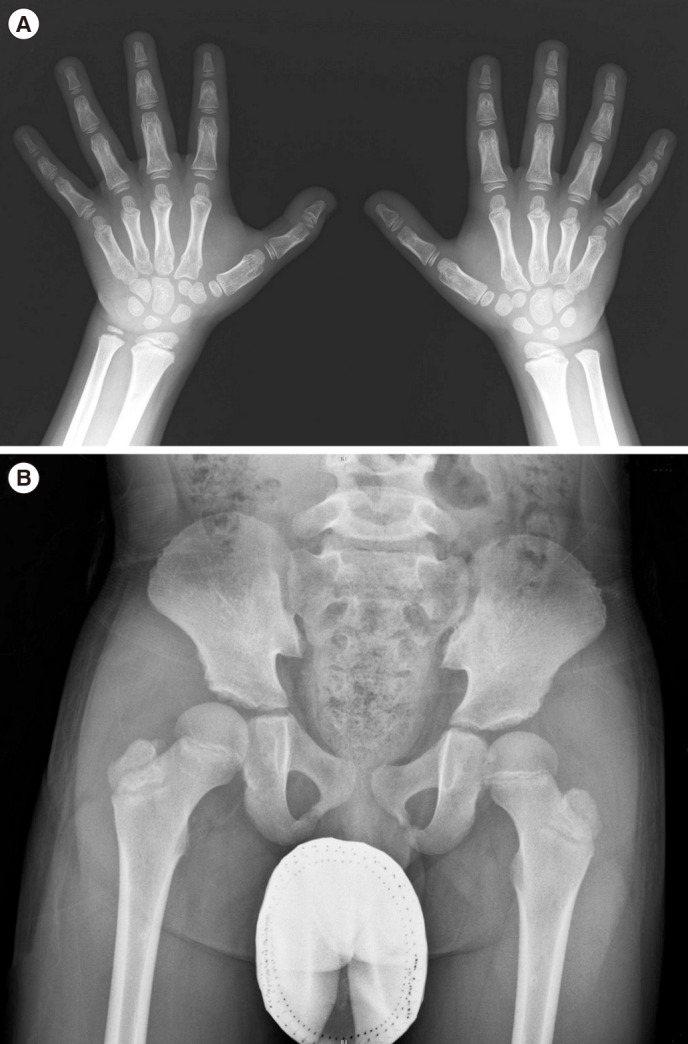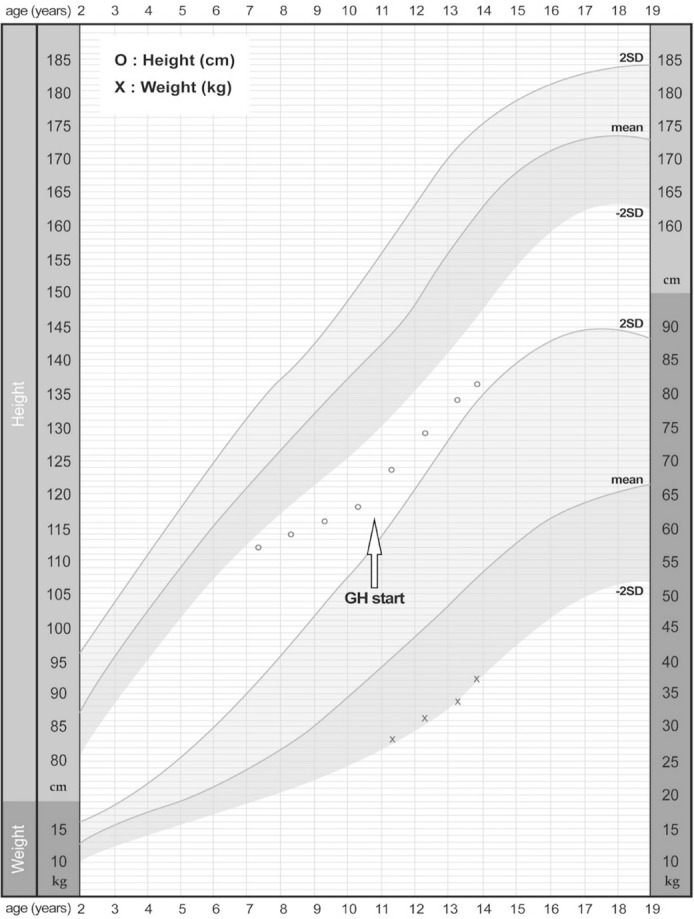Ann Lab Med.
2017 Jan;37(1):92-94. 10.3343/alm.2017.37.1.92.
Acromicric Dysplasia Caused by a Novel Heterozygous Mutation of FBN1 and Effects of Growth Hormone Treatment
- Affiliations
-
- 1Green Cross Laboratories, Yongin, Korea.
- 2Department of Pediatrics, Myongji Hospital, Seonam University College of Medicine, Goyang, Korea. sjkim0128@mjh.or.kr
- 3Department of Pediatrics, Samsung Medical Center, Sungkyunkwan University School of Medicine, Seoul, Korea.
- 4Department of Laboratory Medicine & Genetics, Samsung Medical Center, Sungkyunkwan University School of Medicine, Seoul, Korea.
- 5Department of Radiology, Woorisoa Children's Hospital, Seoul, Korea.
- KMID: 2373624
- DOI: http://doi.org/10.3343/alm.2017.37.1.92
Abstract
- No abstract available.
MeSH Terms
Figure
Reference
-
1. Faivre L, Le Merrer M, Baumann C, Polak M, Chatelain P, Sulmont V, et al. Acromicric dysplasia: long term outcome and evidence of autosomal dominant inheritance. J Med Genet. 2001; 38:745–749. PMID: 11694546.2. Le Goff C, Mahaut C, Wang LW, Allali S, Abhyankar A, Jensen S, et al. Mutations in the TGFβ binding-protein-like domain 5 of FBN1 are responsible for acromicric and geleophysic dysplasias. Am J Hum Genet. 2011; 89:7–14. PMID: 21683322.3. Cain SA, McGovern A, Baldwin AK, Baldock C, Kielty CM. Fibrillin-1 mutations causing Weill-Marchesani syndrome and acromicric and geleophysic dysplasias disrupt heparan sulfate interactions. PLoS One. 2012; 7:e48634. PMID: 23133647.4. Wang Y, Zhang H, Ye J, Han L, Gu X. Three novel mutations of the FBN1 gene in Chinese children with acromelic dysplasia. J Hum Genet. 2014; 59:563–567. PMID: 25142510.5. Superti-Furga A, Unger S. Nosology and classification of genetic skeletal disorders: 2006 revision. Am J Med Genet A. 2007; 143A:1–18. PMID: 17120245.6. Le Goff C, Morice-Picard F, Dagoneau N, Wang LW, Perrot C, Crow YJ, et al. ADAMTSL2 mutations in geleophysic dysplasia demonstrate a role for ADAMTS-like proteins in TGF-beta bioavailability regulation. Nat Genet. 2008; 40:1119–1123. PMID: 18677313.7. Faivre L, Gorlin RJ, Wirtz MK, Godfrey M, Dagoneau N, Samples JR, et al. In frame fibrillin-1 gene deletion in autosomal dominant Weill-Marchesani syndrome. J Med Genet. 2003; 40:34–36. PMID: 12525539.8. Le Goff C, Cormier-Daire V. Genetic and molecular aspects of acromelic dysplasia. Pediatr Endocrinol Rev. 2009; 6:418–423. PMID: 19396027.9. Faivre L, Dollfus H, Lyonnet S, Alembik Y, Mégarbané A, Samples J, et al. Clinical homogeneity and genetic heterogeneity in Weill-Marchesani syndrome. Am J Med Genet A. 2003; 123A:204–207. PMID: 14598350.10. Hagenäs L, Hertel T. Skeletal dysplasia, growth hormone treatment and body proportion: comparison with other syndromic and non-syndromic short children. Horm Res. 2003; 60(S3):65–70. PMID: 14671400.
- Full Text Links
- Actions
-
Cited
- CITED
-
- Close
- Share
- Similar articles
-
- Clinical effects of yeast derived recombinant methionyl growth hormone in growth hormone deficiency
- Endoscopic Decompression for Optic Neuropathy in McCune-Albright Syndrome
- Effect of yeast-derived methionyl recombinant growth hormone on growth hormone deficient dwarf
- The pharmacokinetics and biological effects of yeast derived recombinant methionyl growth hormone in growth hormone deficient children
- Clinical effects of recombinant Korean growth hormone (LBD-003)



